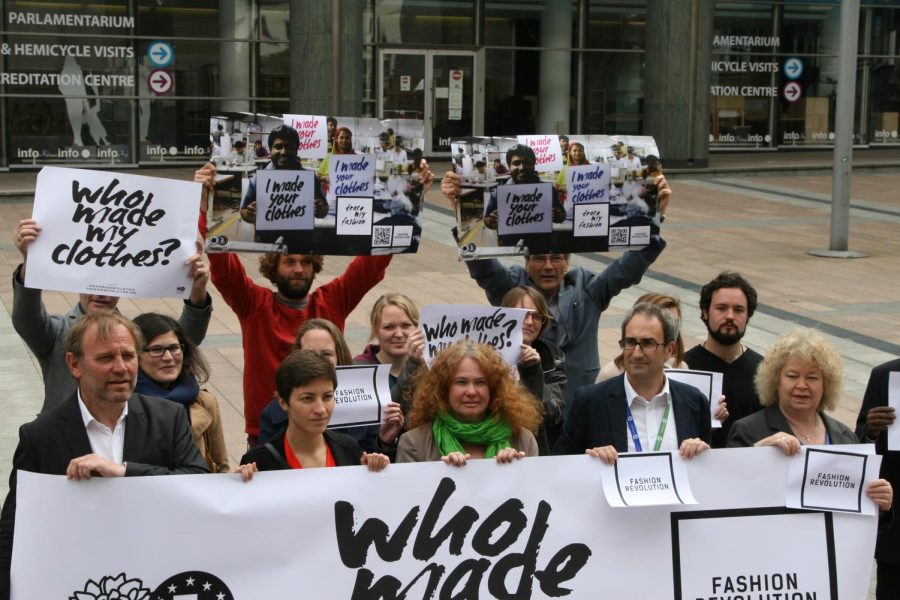How TikTok Glamorized Fast Fashion
Greensefa
This image depicts protesters in Belgium late 2015. The activists were campaigning against fast fashion practices by using The Fashion Revolutions famous slogan “who made my clothes.” Photo courtesy of Greensefa.
October 28, 2021
You’ve probably heard of the famous app called TikTok, and if you haven’t, you’ve definitely heard pop culture references to it. But unsurprisingly, the seemingly wholesome app has spawned mass numbers of toxic cultures and trends, one of which being the glamorization of fast fashion.
The concept of fast fashion is not new. Though the term has become a part of the modern vocabulary, fast fashion has been around since the industrial revolution. The idea is supposedly innocent in nature: clothing that’s cheap to make and affordable for consumers, that also often follows the current fashion trends. However, the reality is not as watered down as the concept. In order to maximize profit and reduce cost, companies use a system of production called sweatshop manufacturing. Sweatshops are small cramped rooms primarily located in South and East Asia that exploit women and child labor for profit. The use of international production makes it hard to pursue unethical practices on foreign waters. The workers are often paid around as little as three cents an hour for a 100 plus hour workweek.
But how is this TikTok’s fault? While TikTok neither invented the idea nor is directly engaged in the industry itself, the app has made it a trend to play into this exploitative system that is fast fashion. TikTok trend cycles are more often than not quick and short-lived, and can be characterized by the large number of people partaking in them, and the trend’s relevance on its main “or You” page. This is because once more people start using tags, audios, and content associated with the trend, TikTok will boost the videos so it reaches a larger audience and more engagement. Subsequently, quick trends that people can buy into and participate in are often the most popular.
In early 2021, it became a trend on the app to buy large amounts of clothes from well-known fast fashion brands such as Shein and Ali Express. Girls would caption their hauls with titles such as “My $500 Shein Haul” and “Buy $300 Worth of Ali Express With Me.” The people buying these mass hauls of clothing are mostly part of the upper-middle and wealthy classes. These groups benefit because instead of spending upwards of $100 on fewer but higher quality items, they can buy mass quantities of clothing for the same price. Though the issue with this is that these socio-economic groups don’t need to purchase cheap rip-offs, they are exactly the demographic that can afford the real thing. So not only do they increase the industry demand for fast fashion by increasing the use of sweatshops, but also the increase in price for people who can’t afford anything but fast fashion. Additionally, so much of these clothes get worn once or twice and don’t get used again due to extremely short fashion cycles, so on top of all other issues, it also hikes up statistical waste within the fashion industry. Because the new “it” item constantly comes and goes so much waste is produced by un-worn and not used clothing.
People who can afford clothing that is mildly ethically made should not be exploiting the cheap clothing prices meant for lower-income individuals because evidently, it will be very difficult to demolish fast fashion practices. This poses the philosophical question of greed. These girls who buy Shein and AliExpress clothes are not in need of all of these items. It is a choice they make because they want more, the on brand pieces that they can afford are not enough to them, they want every cute top or dress that money can buy. However, do they realize the clothes they are wearing were probably made by the hands of a small impoverished child, or a mother trying to make enough money to buy food? This systematic milking of the poor benefits the upper classes at the expense of those who are less fortunate, time and time again those who have less get logged into this vicious cycle. When you already have food, clothes, money, and stability, when will that be enough, when will that satisfy people? We need to stop overconsumption from becoming a trend, and instead, become satisfied with the things we have. We don’t need 30 cute tops for 100 bucks. As consumers, we should be responsible.



